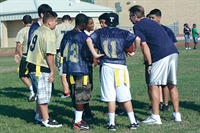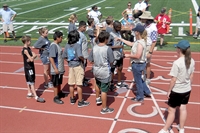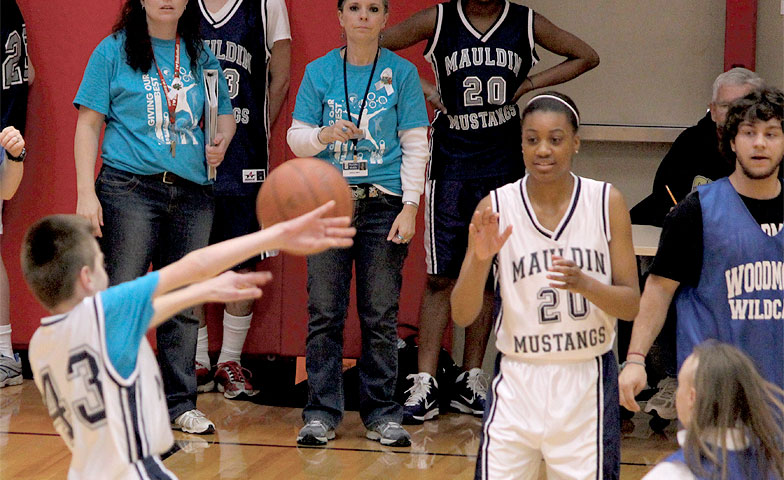In eighth grade, co-author Brian Quinn played on one of his district’s ice hockey teams, which included students from different social circles. He was not in one of the “popular” groups at his school, but being a member of the sports team and interacting with his teammates made him feel better about himself. When people wear the same jersey, practice together, compete and travel together, they develop a unique bond that is difficult to duplicate with other programs.
Brian wasn’t significantly different from his school mates—he just wasn’t one of the popular kids. Imagine what it is like for students who are viewed as different because of a disability. According to a national study on the attitudes of middle school students toward peers with intellectual disabilities, (Exceptional Children, Summer 2007), students said that in school, they had little contact with students with intellectual disabilities and did not want to interact socially with them.
How, then, can students with intellectual disabilities become part of the social fabric of the school?
One answer is Special Olympics Unified Sports®, which brings together athletes with and without intellectual disabilities to train and compete on the same team. In middle level schools, this form of inclusive sports can be implemented as a physical education class, part of an intramural program, or as an interscholastic team that brings together Unified Sports teams within a local region.
Students who participate in Unified Sports
- Learn new sports and skills.
- Experience meaningful inclusion as they play valued roles on a team.
- Socialize with peers to form friendships.
- Demonstrate their abilities to their schools, families, and communities.
Janet Cuppage, a physical education teacher at Highland Junior High School in Gilbert, Arizona, shares the impact that her Unified Sports PE class has on her students: “Students look forward to my class more than any other. They feel like they are needed and important in my class…. They feel responsible to someone else besides themselves. Someone else is counting on them, and they want to rise up.”
Cuppage’s feelings about her students are reinforced by research about young adolescents. The students are generally idealistic, want to make contributions to issues larger than themselves, and show compassion for others. Across the country, schools are using this inclusion model to create a social revolution for all students.
Rodney Brown, principal at Clack Middle School in Abilene, Texas, shares that “Unified Sports allows students to interact one-on-one, and because of this, both benefit in several ways. Students see by participating that every student has a basic need to be accepted for who they are and … can form a lasting positive relationship. It also allows all students to better understand special needs students.”
Cuppage agrees: “Unified Sports gives kids the opportunity to be involved with other students as people. These ongoing interactions build character and fight biases. …Unified Sports teaches them to think outside of themselves, and all students get to feel valued.”
Better Understanding

Students huddle up for Unified Sports flag football at Dueitt Middle School, Spring Independent School District, Texas.
When students are consistently working together, they develop a better understanding of one another. With this understanding come true friendships and respect. We see this translated beyond the playing field and into the hallways. Students become the strongest advocates for each other and help reduce bullying at the source.
Kelly, a student at Haddam-Killingworth Middle School in Killingworth, Connecticut, expressed her thoughts in an essay:
One girl with autism was part of a video about “derogatory words” last year, and I was in awe of her standing up for our friend who has Down Syndrome…. Most of the time it hurts me when I see that [students with intellectual disabilities] know that people may call them mean names or make fun of them…. Whenever someone uses the derogatory and hurtful word “retarded,” I immediately reprimand them…. The Unified Sports class has reminded me that all men are created equal, and I am relieved that this saying finally has total and complete meaning.
Educators generally want to include students with disabilities in sports and other programs; however, they often are unsure how to create these inclusive opportunities. Sometimes educators give these students a role as team manager or give them the opportunity to play at the end of a blow-out game. While the intentions are good, the school staff must provide all students with a true sports experience where everyone can achieve meaningful success.
Equal Opportunities

Unified Sports at Dueitt Middle School, Spring Independent School District, Texas, includes track.
Special Olympics Unified Sports is an established model that has been working in schools for more than 20 years. Internationally recognized rules and models help structure teams and guide competitions. All students have the opportunity to be meaningfully involved on a team, to contribute their own unique strengths and talents, and to be recognized by others for special skills and attributes. All students—those with and without intellectual disabilities—are expected to follow the same rules and are held accountable for their actions.
Providing each student with the opportunity to be actively engaged in school athletics is not just the hope of a few. Several months ago, the U. S. Department of Education Office of Civil Rights released a letter clarifying each school’s responsibility to ensure that students with disabilities have equal opportunities to participate in extracurricular sports.
This is not a new law, but it clarifies Section 504 of the Rehabilitation Act of 1973: “When the interests and abilities of some students with disabilities cannot be as fully and effectively met by the school district’s existing extracurricular athletic program, the school district should create additional opportunities for those students with disabilities.” Unified Sports helps education leaders address this guidance so that all students are engaged meaningfully in athletics.
We are delighted that these civil rights are receiving attention, but we want schools to join the movement toward inclusion because it is good for all students and good for the culture of the school. We have seen repeatedly that Unified Sports creates a comfortable and inviting environment for all students, encouraging those who may not have typically engaged in sports to become active.
For example, Jane, a student in Ms. Cuppage’s class, did not have an intellectual disability but did have a heart condition, which often made her feel like an outsider in her PE classes. Jane transferred to one of the Unified Sports sections and was able to help another student do her best without being judged by what she, herself, couldn’t do. Being valued for what she could do was motivational for Jane and for the intellectually disabled student with whom she was working.
Conversely, Unified Sports can give elite athletes a new perspective on competition and sportsmanship. The book Perfect Game, by Washington Post sports columnist and acclaimed youth author Fred Bowen, follows Isaac, a short-tempered 13-year–old who is trying to make a junior league all-star team. Along his journey, he accidentally discovers Unified Sports where he meets a new set of athletes who show him a different way to think about being “perfect.”
Chances for All
Much like Brian’s middle school hockey experience, the ongoing interaction that takes place in Special Olympics Unified Sports helps break down barriers and erase pre-conceived differences among students. It helps to shatter stereotypes about people with intellectual disabilities in a fun and inclusive environment. Everyone deserves the chance to have friends and experience the “thrill of the game.”
Brian Quinn is the manager of Youth Education & Unified Sports® for Special Olympics North America Project UNIFY.
![]() bquinn@specialolympics.org
bquinn@specialolympics.org
Betty Edwards, the former executive director of the Association for Middle Level Education, is chair of the Special Olympics Project UNIFY National Education Leaders Network.
![]() bedwardsk@aol.com
bedwardsk@aol.com
Published in AMLE Magazine, October 2013.
